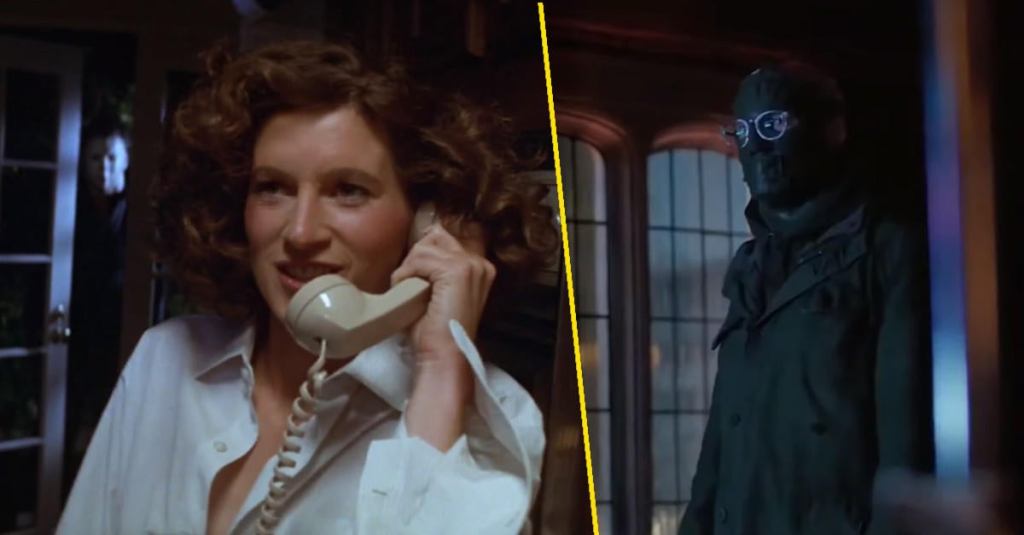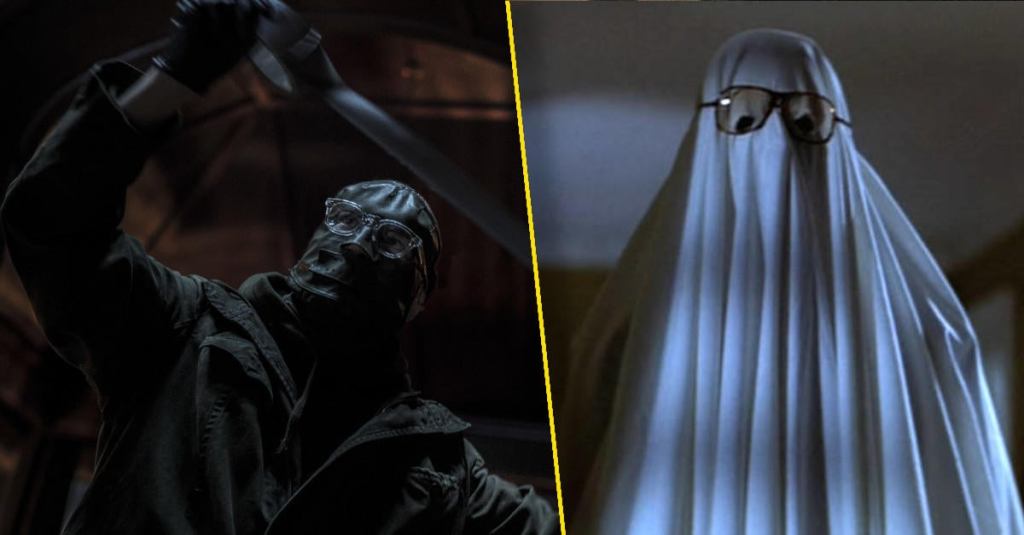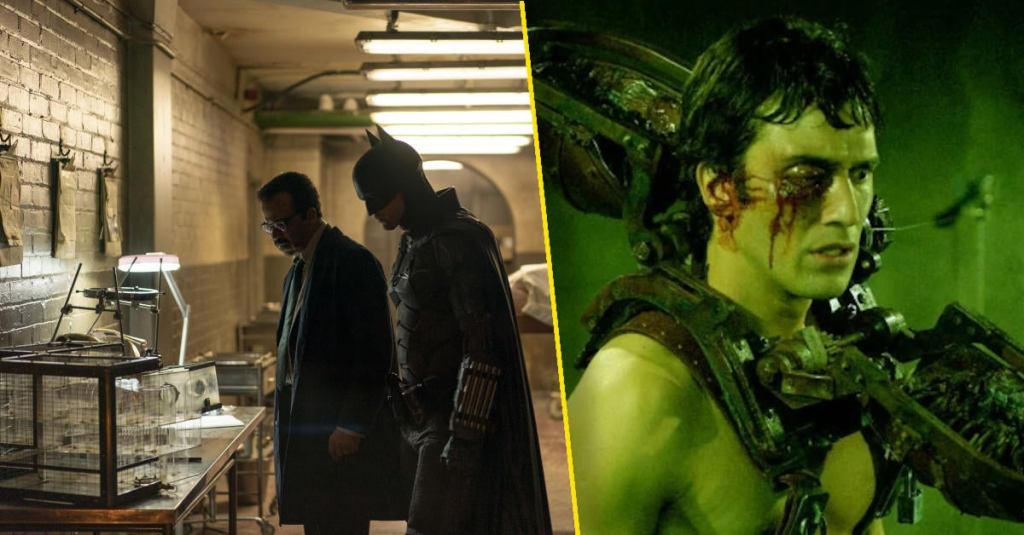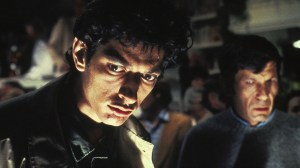Since promotion on The Batman began, director and co-writer Matt Reeves has been open about the fact that among the biggest influences on his film were detective stories. Noir classic Chinatown and Alan Pakula’s Klute & All The President’s Men were among the titles specifically namechecked by the director as films that were baked into the DNA of his new movie. With the DC film now playing in theaters, though, it’s not only clear that Reeves had all of these in mind while making the movie but there were a couple of other films at play for this new take on the Dark Knight Detective, and they were found in the green-sticker’d Horror section of the video store. Spoilers follow!
Videos by ComicBook.com
The opening scene of The Batman is a POV shot from the perspective of Paul Dano’s Riddler. Through a pair of binoculars, Riddler watches Gotham Mayor Don Mitchell Jr. in his home as his child prepares to go out trick or treating in a ninja costume. This specific shot, coupled with the setting, is clearly modeled after John Carpenter’s 1978 masterwork, Halloween. The iconic slasher film begins with a POV shot from the young Michael Myers who wanders through his family home, eventually murdering his sister. Though Reeves doesn’t invoke the Panaglide motif that made Carpenter’s first shot so famous, it’s an undeniable allusion, complete with the heavy breathing of Dano’s character which would become a staple of Myers across the Halloween franchise.

The influence of Halloween doesn’t end with this one shot, however, as the next sequence brings us inside the home with Mitchell pacing back and forth while watching a news broadcast about the upcoming election. During his pacing, there’s a second room behind him, the television the only source of light illuminating the entire space. At a certain point Mitchell turns to walk in a new direction and it becomes clear that standing behind him for an undisclosed amount of time is Dano’s Riddler, perfectly still, only his eyes following his victim. Though the eye movement is distinctly un-Myers like, the sudden appearance of the killer behind their target is also a quintessential Halloween trope.
One last piece of the scene that’s clearly rooted in Halloween? It might be a stretch, but the Riddler’s outfit, with his glasses sitting over the mask, is quite similar to Michael Myers disguising himself as Bob in the original film. This version of Riddler is clearly primarily modeled after the Zodiac, but this minor Myers detail is tough to ignore.

The Halloween influence on The Batman and its version of The Riddler also doesn’t stop there. Later in the film, when Dano’s killer is stalking Peter Sarsgaard’s District Attorney character Gil Colson, he recreates yet another sequence from Carpenter’s movie. In the film Riddler watches Colson from across the way, breathing heavy once again, harkening back to the countless other stalking scenes from Halloween. When Colson returns to his car things really kick into Halloween territory, as Riddler appears from the backseat and attacks him from behind, even fogging up the windows and forcing an extended horn honk just like when Myers attacks Annie Brackett in the original movie.
Carpenter’s slasher isn’t the only horror film baked into the bones of The Batman; the movie with an even bigger amount of influence on it is David Fincher’s Se7en. Though the semantics of its genre label might be up for debate, Se7en is at its essence a detective movie about an obsessed serial killer with a big plan, making The Batman a clear cousin. It’s not just in plot construction and near continuous rainfall that The Batman and Se7en are similar, but also in its villain’s plans and their abodes. The hideout for both Riddler and John Doe are eventually found by police and shown to include mountains of handwritten journals.
The schemes of both John Doe in Se7en and The Riddler in The Batman also share similar foundations. The killer in Fincher’s movie believes himself to have been sent by a higher power to shock the world and wake it up, a sentiment quite similar to The Riddler’s intentions of shaking Gotham City to its core with the conspiracy that he is trying to unearth. There’s also the means by which both of them carry out their twisted brands of justice, giving their victims just enough wiggle room to potentially live, with most of them failing to make it out alive.

Branching off from Se7en, though, is an entire horror series that clearly had an influence on The Batman: Saw. The torture franchise may not seem like an obvious reference point for the DC Comics adaptation, but some of the similarities are undeniable. Already itself a descendant from Se7en due to the killer’s means, methods, and practices, Saw differentiates itself from Se7en by its elaborate “traps,” which The Batman borrows from in spades.
Though never shown in the gory detail that the Saw franchise reveled in, The Batman on multiple occasions depicts
the torture devices that The Riddler builds and places his victims inside of, and they belong among the items created by Jigsaw. One of these, a rat maze that leads the little nibblers to the victim’s eyes, might appear indistinguishable from other Saw traps to those unfamiliar, while the film’s neck-bomb attached to D.A. Gil Colson is reminiscent of several devices of that nature from the series. Some might argue that The Riddler never gave his victims a chance to make it out alive like Jigsaw, but there were plenty of unwinnable games throughout the Saw franchise too. There’s also the huge words written on the walls of decrepit locations, of which there appears to be an endless supply, a recurring motif in Saw movies and apparently The Batman‘s Gotham.

There’s also the third act reveal that comes after The Riddler has been arrested and imprisoned: he’s not working alone and has acolytes helping him to carry out his work. Saw fans know good and well that “secret apprentices” have been a staple of that series since Saw II, and in both The Batman and Saw the followers even dress like the mastermind.
Still not buying it? Matt Reeves himself thinks of the movie as being inspired by horror.
“I wanted to make the movie kind of a horror movie too,” Reeves said on the Hero Nation podcast. “Because I thought Batman is kind of born out of horror sensibility as well. So I wanted you to have all these experiences and I wanted it to be immersive.”
By fully entrenching itself in these stylistic and narrative choices that are deeply rooted in horror filmmaking and storytelling, The Batman has set itself apart from other versions of the character to yet another degree. Every director has brought their own set of tools to adapting the DC Comics icon, and by dipping into the realm of storytelling techniques and motifs that horror fans are used to seeing Matt Reeves has brought tools into the light that many movie goers don’t experience regularly, and in doing so made a unique and sometimes frightening Batman universe. You can decide for yourself how successful he was at adding those horror sensibilities, as The Batman is playing in theaters worldwide.








